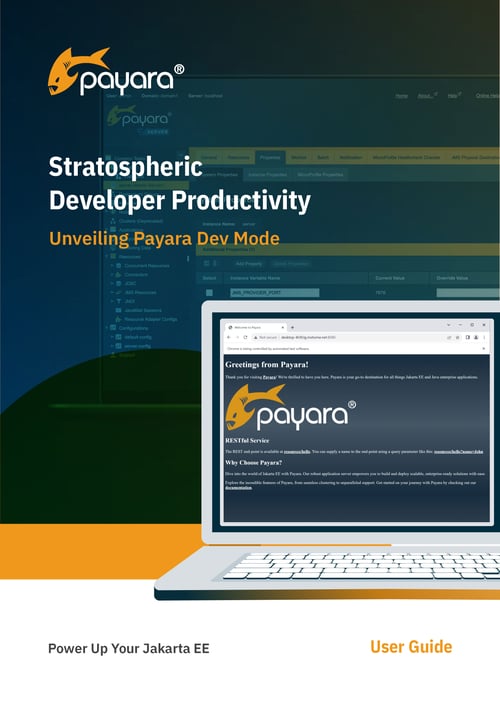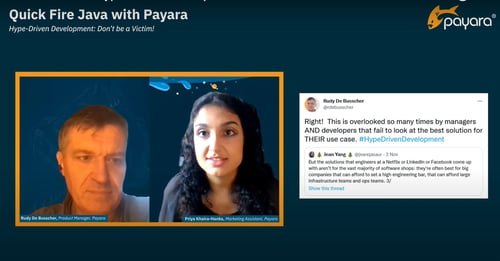Posts tagged DevOps (2)
Payara Cloud Connectivity: Linking Your Apps to Essential Backend Services
Published on 19 Aug 2024
by Luqman Saeed
Topics:
Cloud,
MicroProfile,
DevOps,
Developer,
Payara Cloud,
deployment group,
Getting Started with Payara Cloud,
Jakarta EE
|
0 Comments
Payara Cloud, our increasingly popular Payara as a Service (PaaS) offering, automates the cloud deployment of your Jakarta EE and MicroProfile applications, making it easy to connect to essential services that your application relies on. This post shows you how to connect your applications to the services they need. This quick tutorial applies whether those services are inside or outside your cloud environment, as long as they are reachable across the internet.
Payara Platform Roadmap Update - August 2024
Published on 15 Aug 2024
by Ilias Efstathiou
Topics:
Java EE,
DevOps,
Developer,
Payara Platform,
Java,
Jakarta EE
|
0 Comments
Now that we're eight months into 2024 (already!?), and in the middle of summer, it seems like a good time to catch up and update you on the Payara Roadmap for 2024 - let's see what we've done and what we are still planning to do for the rest of the year and beyond.
You can also watch the Payara Roadmap Update presented at the Virtual Payara Conference last month.
Ensuring Seamless Operations and Maximum Profitability: Key Insights on Application Server Efficiency and SLAs - Part 2
Published on 12 Aug 2024
by Chiara Civardi
Topics:
Ops Teams,
Upgrade,
DevOps,
Monitoring,
Developer,
Payara Support,
Migration,
Payara InSight,
deployment group,
service
|
0 Comments
Robust and efficient application servers are crucial for companies relying on software applications, whether supporting e-commerce platforms, financial services portals, or internal operations. To ensure smooth operations and deliver seamless services to users, it's essential to partner with vendors who can provide a system runtime that offers maximum uptime. This reduces costs and optimizes performance, profitability, and user satisfaction. Effective service level agreements (SLAs) with these vendors play a key role in minimizing disruptions and ensuring that your applications run efficiently and reliably.
In this blog post, we share insights from industry players on what to look for in application runtime SLAs to minimize disruptions.
How To Make Your Apps Work All The Time
Published on 29 Jul 2024
by Chiara Civardi
Topics:
DevOps,
Developer
|
0 Comments
With business running around the clock, customers and staff expect uninterrupted access to key software applications, making uptime essential to deliver optimum user experience. By implementing strategies aimed at keeping applications online, operational and responsive, companies can enhance their profitability, profile and overall competitiveness in the marketplace.
We interviewed our experts Luqman Saeed, Fabio Turizo and Patrik Duditš to help you with a few key tips on how to develop applications with high availability, consistency and reliability.
When Is It Time To Move From Payara Community to Payara Enterprise?
Published on 23 Jul 2024
by Valentina Kovacic
Topics:
DevOps,
Developer,
Payara Enterprise,
Payara Community
|
0 Comments
“Which version of the Payara Platform is right for me?” We get asked this question all the time, so we wanted to provide you with a more in-depth discussion that outlines the similarities and differences between the two editions of the Payara Platform, Enterprise and Community, to help you choose the one that best fits your needs.
Ensuring Seamless Operations and Maximum Profitability: Key Insights on Application Server Efficiency and SLAs - Part 1
Published on 18 Jul 2024
by Chiara Civardi
Topics:
Ops Teams,
Upgrade,
DevOps,
Monitoring,
Developer,
Payara Support,
Migration,
diagnostics
|
0 Comments
Robust and efficient application servers are essential for companies relying on software applications, whether these support e-commerce platforms, financial services portals or internal operations. To help ensure smooth operations, deliver seamless services to users and generate revenue, it’s important that the runtime in place can offer maximum uptime to reduce cost while optimizing performance, profitability and user satisfaction.
In this blog post, we share insights from industry players on the impact of unexpected application server issues and downtime as well as how to reduce them.
No-Code Jakarta EE & MicroProfile Cloud Hosting for Startups: Payara Cloud
Published on 18 Jun 2024
by Luqman Saeed
Topics:
DevOps,
Developer,
Kubernetes,
Payara Cloud,
Getting Started with Payara Cloud,
start-ups
|
0 Comments
Start-ups are hotbeds of innovation, where speed, agility and resourcefulness are key to success. But in the world of enterprise Java applications, managing complex cloud deployment infrastructure can quickly become a bottleneck and take up considerable time from your developers. To address these issues and streamline cloud deployments, we created Payara Cloud.
Troubleshooting Common Payara Cloud Deployment Issues
Published on 04 Jun 2024
by Luqman Saeed
Topics:
DevOps,
Payara Cloud,
Jakarta EE
|
0 Comments
Deploying applications on Payara Cloud offers numerous advantages, including ease of use and scalability. However, like any platform, you might encounter some common issues. The good news is that these problems are typically easy to resolve. Below, we’ll explore common issues, compiled based on the expertise of our service team. For detailed steps and additional support, refer to our comprehensive troubleshooting guide.
Stratospheric Developer Productivity - Unveiling Payara Dev Mode
Published on 19 Apr 2024
by Chiara Civardi
Topics:
Maven,
Payara Micro,
DevOps,
Payara Platform,
Java,
Jakarta EE
|
0 Comments
Development productivity is crucial in Enterprise Java and Jakarta EE application development, supporting the delivery of high-quality software solutions quickly and efficiently. As a result, it is necessary to focus on streamlining development processes, optimizing resource utilization and empowering developers to work more effectively. Payara Micro Maven Plugin, Version 1, introduces a powerful tool – Dev Mode – designed to supercharge your development experience with Payara Micro.
In our latest User Guide - available to download here - we look at this plugin, exploring its features, configurations and usage to help developers unlock stratospheric levels of productivity.
Hype-Driven Development: Don't Be a Victim!
Published on 21 Dec 2021
by Priya Khaira-Hanks
Topics:
Java EE,
Cloud,
DevOps,
JakartaEE
|
0 Comments




-1.jpg?width=500&name=Enterprise%20vs%20Community%20Landscape%20JPG-01%20(1)-1.jpg)




